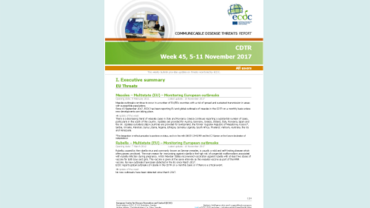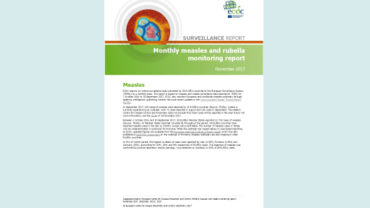Measles in the EU/EEA: current outbreaks, latest data and trends – November 2017
Measles outbreaks continue to occur in a number of EU/EEA countries, and there is a risk of spread and sustained transmission in areas with susceptible populations. New data published today by ECDC in the Communicable Disease Threat Report (CDTR) show that from January 2016 to November 2017, more than 19 000 measles cases were reported in the EU, including 46 deaths. The CDTR also shows that the highest number of cases in 2017 were reported in Romania (7 759), Italy (4 775) and Germany (898). Greece is currently experiencing a measles outbreak, with 368 cases, and one death, reported since May 2017. The spread of measles across Europe is due to suboptimal vaccination coverage in many EU/EEA countries. ECDC is also publishing today the monthly measles and rubella surveillance monitoring report, that provides more in-depth analysis of the situation.
Of all measles cases reported across the one-year period 1 October 2016 – 30 September 2017 with known vaccination status, 86% were not vaccinated. Measles increasingly affects all age groups across Europe; in 2017, 47% of measles cases with known age were aged 15 years or older. The four countries mostly affected by measles over 2016 and the first half of 2017 show different trends: Romania saw a sharp increase in cases from October 2016, and the trend continues in 2017; in Italy, the increasing trend started in January 2017, while in Germany it began in February 2017; Greece has seen a measles outbreak starting in the second half of 2017, with 153 cases reported since mid-October. This data is based on analysis of the cases notified to ECDC and included in the monthly and biannual monitoring reports.
The latest available figures on vaccination coverage collected by WHO (2016) show that the vaccination coverage for the first dose of measles was below 95% in 18 of 30 EU/EEA countries; for the second dose of measles, it was below 95% in 20 of 27 EU/EEA countries reporting second dose coverage data.
In order to achieve the measles elimination goal, the vaccination coverage rates for children targeted by routine vaccination programmes should increase in a number of countries, as the vaccination coverage of the second dose must be at least 95% to interrupt measles circulation and achieve herd immunity. This is particularly important to protect children below one year of age, who are particularly vulnerable to complications of measles but are too young to have received the first dose of vaccine.






